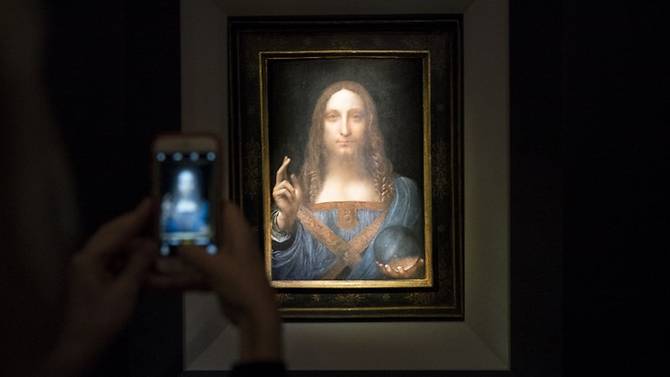Da Vinci painting fetches US$450.3m in auction record: Christie's
 |
| A visitor takes a photo of the painting 'Salvator Mundi' by Leonardo da Vinci at Christie's New York Auction House, Nov 15, 2017 in New York City. (Photo: AFP) |
The whopping price dwarfed the previous record for the most expensive piece of art sold at auction, set at US$179.4 million for Pablo Picasso's The Women of Algiers (Version O) by Christie's in 2015.
The auction house says Salvator Mundi or Saviour of the World is one of fewer than 20 Da Vinci paintings in existence that are generally accepted as from the Renaissance master's own hand.
All other known paintings by Da Vinci are held in museum or institutional collections.
Dated back by the auction house to around 1500, the oil on panel sold after 18 minutes of frenzied bidding in a historic sale, the star lot of the November art season in the US financial capital.
Whoops and applause rippled through the showroom as the bids quickly escalated into unchartered territory, led by rivals on the telephone.
"An historic moment here. We'll wait," said auctioneer Jussi Pylkkanen in a brief pause in bidding at US$300 million.
He eventually hammered the painting at US$450 million. The final price came to US$450.3 million including the buyer's premium.
The price throws shade at its Russian billionaire seller, who has sued a Swiss art dealer in Monaco for allegedly swindling him into parting with US$127.5 million for the work in 2013.
Dmitry Rybolovlev, the boss of soccer club AS Monaco, accuses Yves Bouvier of conning him out of hundreds of million dollars by overcharging him on a string of deals, and pocketing the difference.
Salvator Mundi at been at the heart of that court battle.
Bouvier bought the work at Sotheby's for US$80 million in 2013. He resold it within days to the Russian tycoon, for US$127.5 million, netting a US$47.5 million profit. Bouvier denies any wrongdoing.
The work was exhibited at The National Gallery in London in 2011, after years of research trying to document its authenticity after it was found, mistaken for a copy, in a regional US auction in 2005.
Before that it had disappeared for years, previously fetching a mere £45 (US$60 in today's money) in 1958 as a believed copy.
Christie's said pre-sale that the painting's rarity was difficult to overstate. For years it was presumed to have been destroyed, emerging only in 2005 when it was purchased from a US estate.
"For auction specialists, this is pretty much the Holy Grail," Loic Gouzer, co-chairman of Christie's Americas postwar and contemporary art department, has said. "It doesn't really get better than that."
What the stars mean:
★ Poor ★ ★ Promising ★★★ Good ★★★★ Very good ★★★★★ Exceptional
Latest News
More News
- Vietjet resumes Con Dao flights from early December (November 28, 2025 | 15:24)
- Free tickets, Lunar New Year promotions on offer at Vietjet Mega Livestream (November 26, 2025 | 15:32)
- UNIQLO unveils upgraded heat-retention wear at Hanoi event (October 26, 2025 | 10:00)
- Vietnam named among world’s top four culinary destinations (October 24, 2025 | 17:09)
- Vietnam and Denmark strengthen dialogue on sustainable fashion (October 20, 2025 | 09:11)
- Fusion rolls out special initiatives to celebrate Vietnamese Women’s Day (October 17, 2025 | 20:00)
- Showcase AC 2025 set to light up Hanoi stage (September 12, 2025 | 18:06)
- Hotel Indigo Saigon The City hosts event to reimagine city’s beloved alleyways (July 23, 2025 | 17:04)
- UNIQLO’s sustainability strategy behind the brand's global growth (June 23, 2025 | 15:42)
- Vietnam International Travel Mart 2025 kicks-off in Hanoi (April 10, 2025 | 17:50)

















 Mobile Version
Mobile Version